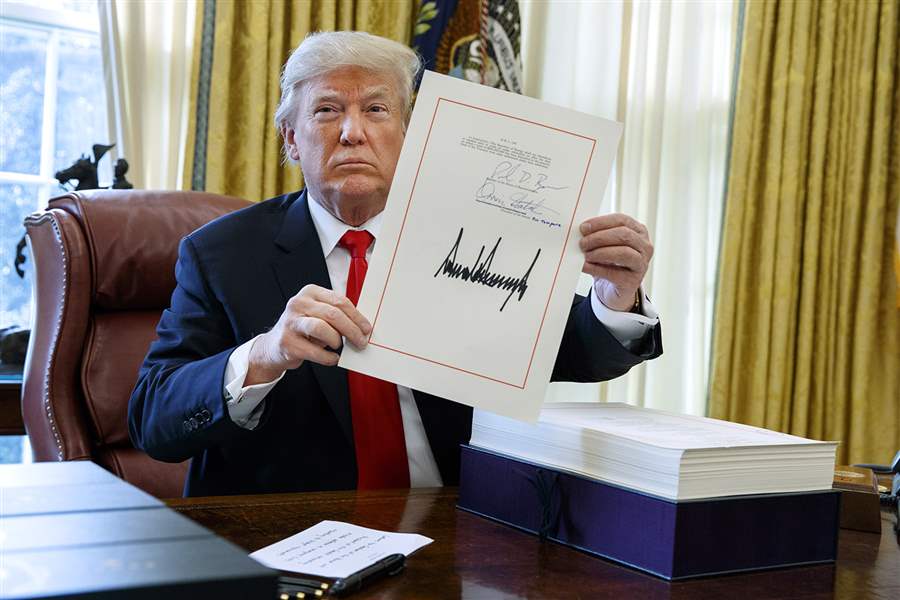
Local companies see varied results from slashed corporate tax rate
3/9/2018
President Donald Trump shows off the tax bill after signing it in the Oval Office of the White House, Friday, Dec. 22, 2017.
ASSOCIATED PRESS
Amid fanfare, President Trump signed his name in December to what has become the signature legislation thus far of his presidency, the U.S. Tax Cuts and Jobs Act.
Right out of the gate, a few companies boasted of how the tax cuts would allow them to offer bonuses to employees.
And it is true that by cutting the corporate income tax rate to 21 percent from a previous 35 percent, the law turned out to be an immediate shot in the arm for some companies, while offering a promise of more cash for investment — and more jobs — in the future.

President Donald Trump shows off the tax bill after signing it in the Oval Office of the White House, Friday, Dec. 22, 2017.
But the change in the corporate tax rate, which took effect Jan. 1, wasn’t an immediate boon for every company.
“It really depended on (a company’s) tax position coming into this change. Did you have deferred tax assets or deferred tax liabilities?” said Eric Toder, co-director of the Urban-Brookings Tax Policy Center, a nonpartisan think tank based in Washington, D.C.
A deferred tax asset is an accounting term that refers to when a business has overpaid taxes or taxes paid in advance on its balance sheet. These taxes are eventually returned to the business in the form of tax relief, making the over-payment an asset for the company.
A deferred tax liability is the opposite. When a company delays its tax payments, it creates a deferred tax liability which means it has a future tax obligation.
However, lowering the tax rate upset the tax apple cart, so to speak. Deferred assets that were valued at a 35 percent tax rate will now be valued at a 21 percent rate.
Deferred liabilities that were subject to a 35 percent tax rate, now only have to face a 21 percent tax liability going forward.
In simple terms, companies that have a lot of deferred assets have lost some of the value of those assets. Those that have a lot of liabilities are winners in that they will pay less in taxes.
Usually, companies have both deferred tax assets and liabilities.
How they were reconciled against each when the tax rate change occurred resulting in accounting gains or losses for 15 publicly-traded companies in northwest Ohio.

The Andersons, Inc. is one of 5 companies in northwest Ohio that posted an accounting gain after the passing of the U.S. Tax Cuts and Jobs Act.
Five companies in the region that recorded gain are — The Andersons Inc. ($74.2 million), Cooper Tire & Rubber Co. ($55.8 million), Welltower Inc. ($17.4 million), SB Financial Group ($1.7 million), and Marathon Petroleum Corp. ($1.5 billion).
Seven companies recorded losses or one-time charges to resolve the effect of the tax change — Dana Inc. ($186 million), First Defiance Financial Corp. ($154,000), Libbey Inc. ($6.7 million), La-Z-Boy Inc. ($9.5 million), MBT Financial Inc. ($4.3 million), Owens Corning ($82 million), and United Bancshares Inc. ($1.4 million).
Three other companies, Cedar Fair LP, Owens Illinois Inc., and Farmers & Merchants Bancorp Inc., reported no immediate impacts.
“We had both (assets and liabilities). The tax assets that we wrote down so we could pick up on the difference on the liabilities,” said Don Hileman, CEO and President of First Defiance Financial Group, of Defiance.
“We had more tax assets so that it didn’t affect us that much,” he said, referring to its $154,000 charge against earnings.
MBT Financial Inc., of Monroe, also took a paper loss of $4.3 million.
“Generally, banks would have deferred tax assets. Under the tax change they would have to revalue those assets lower — and that’s what happened to us,” said John Skibski, chief financial officer of MBT Financial.
The bank easily handled the one-time loss. “We have a pretty healthy cushion,” Mr. Skibski said.
Mr. Toder said it’s important to remember that the recorded gains and losses are mostly on paper. “It hasn’t really to do with the amount of money companies are sending to the IRS. It has to do with the question of how accountants are crediting these assets and liabilities on their books,” he said.
But for banks, a write down has a real-world effect. “It decreases our capital,” Mr. Skibski said.
MBT is safe, but for a less stable bank such a hit “could knock a bank down in its capital rating,” Mr. Skibski said.
For those holding more liabilities than assets, the revaluation of those liabilities also had some real effects.
Marathon, for example, got a tax benefit of $1.5 billion as a result of remeasuring some of its deferred tax liabilities using the lower corporate tax rate.
CEO Gary Heminger said in a talk with Wall Street analysts that the reduced corporate tax rate will be a catalyst for an incremental business investment at Marathon.
Timothy Griffith, Marathon’s chief financial officer, said the company estimates tax reform will provide “something in the order of $400 million to $500 million savings of cash taxes.”
But for First Defiance, which plans to invest in low income housing, the change now means that asset will only generate a 21 percent tax advantage going forward instead of a previous 35 percent tax advantage.
“We’ll still do it because we don’t do it just for the tax benefit. We do it for the community,” Mr. Hileman said.
“But that change to 21 percent might have some impact on that type of product line in the future.”
Overall, the tax reform is a positive for the economy, the bank CEO said.
“As long as there’s other stabilization within the other parts of the economy I think in general the tax law change is a benefit. It will stimulate the economy and allow for more investment,” Mr. Hileman said.
Mr. Toder agreed.
“In terms of things like the incentive to invest, you actually have an incentive to invest now. If you buy new equipment for your plant, the taxes on those new investments will be lower,” Mr. Toder said.
“From the point of view of these companies it should be a thumbs-up,” he added. “With the qualification that some of these companies are going to take a hit on their books now.”
Contact Jon Chavez at jchavez@theblade.com or 419-724-6128.